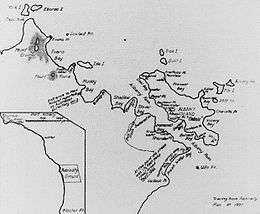Djagaraga
| Native name: <span class="nickname" ">Pabaju | |
|---|---|
 Admiralty Plan No. 1937. Plan drawn in 1862 showing site on Albany Island advised for the proposed Cape York Station, and the best position for the township on the mainland opposite. | |
| Geography | |
| Administration |

The Djagaraga, Gudang or Yatai are an Australian Aboriginal tribe, traditionally lived in the coastal area from Cape York to Fly point, including also Pabaju (Albany Island),[1] in the Cape York Peninsula, Queensland. In the early period of white settlement as the Somerset tribe, after the settlement of Somerset established on their lands in 1863.
Language
They spoke Djagaraga, which according to Kenneth L. Hale’s classification, was one of 10 languages of a northern Paman subgroup.[2]
Society
Nonie Smith states that their ‘relations with the Western Torres Strait Island people the Kaurareg were ‘so close that despite their distinct identity they could be regarded almost as an outpost of the latter.’[3] They also shared trade, kin and ritual links with their eastern coastal tribal neighbour, the Unduyamo Some recent scholarship, basing its inferences on the density of ceremonial rock structures throughout the territory of the Gudang and Unduyamo, speculates that they may have functioned as ceremonial masters for rites of initiation and the magical increase of natural species also for the Torres Strait peoples with whom they had close relations of trade, marriage and religion.
Notes and references
Notes
- ↑ Moore 1979, p. 299.
- ↑ Dixon 2002, pp. xxx-xxxi,660.
- ↑ Sharp 1992, p. 14.
References
- Dixon, Robert M. W. (2002). Australian Languages: Their Nature and Development. 1. Cambridge University Press. ISBN 978-0-521-47378-1.
- Greer, Shelley; McIntyre-Tamwoy, Susan; Henry, Rosita (2011). "Sentinel Sites in a cosmo-political seascape" (PDF). 7th International Small Islands Conference, Airlie Beach, Whitsundays. pp. 2–10.
- Moore, David R. (1979). Islanders an d Aborigines at Cape York. Australian Institute of Aboriginal Studies. ISBN 978-0-855-75082-4.
- Sharp, Nonie (1992). Footprints Along the Cape York Sandbeaches. Aboriginal Studies Press. ISBN 978-0-855-75230-9.